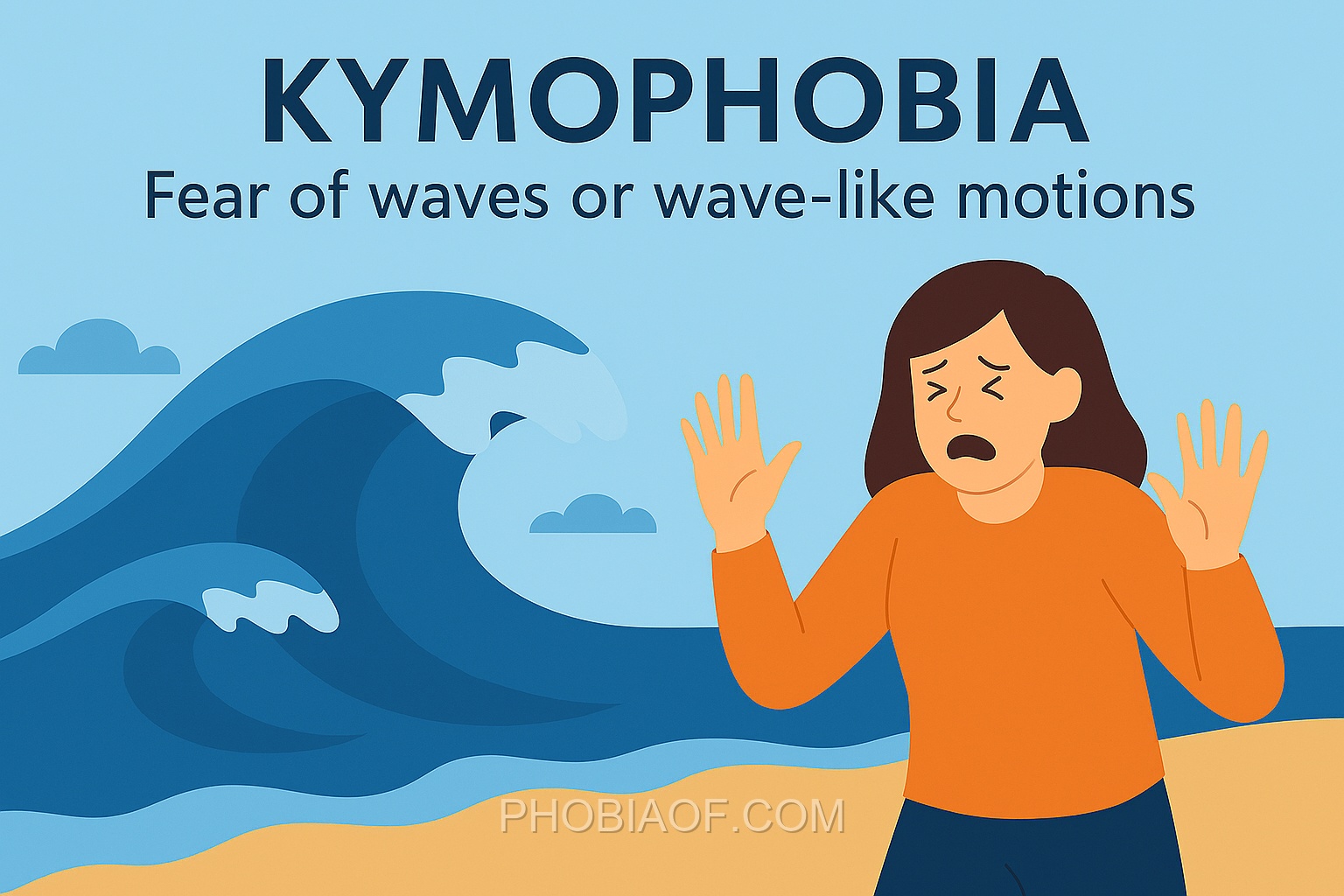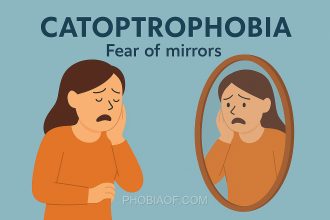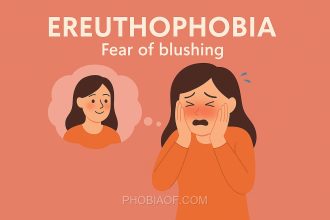Have you ever stood at the shore, watching the waves crash, only to feel a sudden rush of anxiety instead of awe? If so, you might relate to a condition known as Kymophobia.
Kymophobia is the fear of waves or wave-like motions. Derived from the Greek words “kyma,” meaning “wave,” and “phobos,” meaning “fear,” this phobia can manifest as an intense and irrational dread of the undulating movements that are a natural part of our world.
For those affected, these fears can be overwhelming, making it difficult to enjoy activities that involve water bodies, such as a day at the beach or a boat ride. The anxiety isn’t limited to ocean waves; it can also include wave-like motions seen in other contexts, like the gentle ripples of a lake or even the motion of a crowd.
- Individuals with Kymophobia may experience physical symptoms such as sweating, rapid heartbeat, or even panic attacks when confronted with waves.
- This fear can interfere with daily life, potentially leading to avoidance of activities that many find relaxing or enjoyable.
- Understanding and addressing these fears with compassion and professional support can help individuals manage their symptoms and regain control over their lives.
By shedding light on Kymophobia, we can foster greater empathy and support for those who face this unique challenge. Whether it’s through therapy or gradual exposure, there are ways to help those affected find peace amidst the waves.
Causes of Kymophobia
Kymophobia, the fear of waves, can arise from a variety of factors. Understanding these causes can help in addressing and managing this phobia effectively. Below, we explore some potential reasons why someone might develop kymophobia.
- Genetic Predisposition:
Some individuals may have a genetic tendency to develop anxiety disorders, including specific phobias like kymophobia. This genetic predisposition means their brains might be more sensitive to stimuli that trigger fear responses.
- Traumatic Experiences:
Experiencing or witnessing a traumatic event involving water, such as a near-drowning incident or a severe storm at sea, can lead to the development of kymophobia. Such events can create lasting memories and associations with fear.
- Learned Behavior:
Phobias can also be learned from observing others. If a child sees a parent or caregiver reacting fearfully to waves, they might adopt similar reactions. Over time, this learned behavior can solidify into a phobia.
- Psychological Factors:
Other psychological conditions, such as generalized anxiety disorder or post-traumatic stress disorder (PTSD), might contribute to the development of kymophobia. These conditions can heighten sensitivity to fear-inducing situations.
- Environmental Factors:
Exposure to negative media portrayals of waves, such as disaster movies or news coverage of tsunamis, can contribute to the fear. Such exposure can exaggerate perceptions of danger associated with waves.
While the exact cause of kymophobia can vary from person to person, recognizing these factors can aid in understanding and treating this fear. Some researchers suggest that phobias may arise when the brain’s fear-processing mechanisms become overactive or misinterpret non-threatening stimuli as dangerous. This theory highlights the complex interplay between biology and environment in the development of specific phobias.
Symptoms of Kymophobia
Kymophobia, the intense fear of waves or wave-like motions, can significantly impact those who experience it. Individuals with this phobia often endure acute anxiety when confronted with situations involving waves, whether in water bodies or even in visual or auditory stimuli that mimic wave motions. Recognizing the symptoms is the first step toward understanding and managing this phobia. Below are some common symptoms that can manifest physically and emotionally:
- Intense Fear or Anxiety: An overwhelming sense of dread or terror when thinking about or encountering waves in any form.
- Panic Attacks: Sudden episodes of intense fear accompanied by physical symptoms such as chest pain, shortness of breath, or dizziness.
- Sweating: Excessive perspiration, particularly in situations where waves are present or anticipated.
- Rapid Heartbeat: An accelerated heart rate triggered by exposure to wave-related stimuli.
- Trembling or Shaking: Physical shaking often occurs as a reaction to the stress caused by the phobic trigger.
- Nausea: A feeling of sickness in the stomach, which can be induced by anxiety related to waves.
- Avoidance Behavior: Actively steering clear of places or situations where waves might be encountered, such as beaches or swimming pools.
- Overwhelming Dread: A persistent feeling of impending doom or fear related to the thought of waves.
- Difficulty Concentrating: Trouble focusing on tasks due to preoccupation with fears about waves.
- Emotional Distress: Feeling distressed or upset even at the mention or depiction of waves in media.
When severe, these symptoms can significantly interfere with daily life, making it challenging to engage in activities that are otherwise enjoyable or necessary.
Treatment for Fear of Waves or Wave-like Motions
It’s important to begin by reassuring you that Kymophobia, the fear of waves or wave-like motions, is a condition that can be treated and managed over time. With the right approach and support, you can overcome this phobia and regain control over your life. Let’s explore some of the effective treatment options and coping strategies available to help you on this journey.
Proven Therapies
Several therapeutic approaches have been proven effective in treating phobias like Kymophobia:
- Exposure Therapy: This form of therapy involves gradually facing the fear in a controlled and safe environment. By slowly exposing yourself to waves or wave-like motions, you can desensitize your response over time, reducing the fear and anxiety associated with it.
- Cognitive-Behavioral Therapy (CBT): CBT works by changing the fearful thoughts and beliefs associated with waves. Through this therapy, you learn to reframe negative thoughts and develop healthier coping mechanisms to manage your fear.
- Counseling: Speaking with a counselor or therapist can provide you with a safe space to express your fears and anxieties. Counseling helps to explore the root causes of your phobia and develop personalized strategies to overcome it.
Self-Help Coping Techniques
In addition to professional therapy, there are self-help techniques that can complement your treatment:
- Relaxation Exercises: Techniques such as deep breathing, progressive muscle relaxation, and guided imagery can help reduce anxiety and promote a sense of calm.
- Meditation: Practicing mindfulness and meditation can help center your thoughts and reduce the intensity of your fear response.
- Support Groups: Joining a support group with others who experience similar fears can provide encouragement and a sense of community. Sharing experiences and coping strategies can be incredibly empowering.
Medication
While the primary focus should be on therapy and coping skills, medication may be considered for severe cases of Kymophobia. Anti-anxiety medications can help manage symptoms, but they are typically used in conjunction with therapy rather than as a standalone treatment.
Remember, it’s crucial to seek professional help if Kymophobia is interfering with your daily life. A mental health professional can guide you through the most effective treatment plan tailored to your needs.
With time, patience, and the right support, you can overcome your fear of waves and live a fulfilling life. You’re not alone in this journey, and help is available to guide you every step of the way.
Conclusion
Understanding kymophobia, the fear of waves or wave-like motions, can be a crucial step towards overcoming it. By recognizing the causes and symptoms, individuals can begin to address their phobia with informed strategies. Awareness of this fear allows for the identification of triggers and the development of personalized coping mechanisms.
It’s important to remember that phobias, including kymophobia, can often be managed or even overcome with time and the right support. Many people have successfully navigated their fears, emerging stronger and more resilient. If you find yourself struggling with kymophobia, consider reaching out for help. Talking to a mental health professional or a doctor can provide you with the guidance and resources needed to begin your journey toward managing this fear effectively.
Embrace this opportunity to take control of your mental health, knowing that help is available and that many have walked this path before you. With patience and persistence, you can work towards a life less hindered by fear, where the waves of anxiety no longer loom large. Stay hopeful, stay informed, and take the first step towards a brighter, calmer future.






